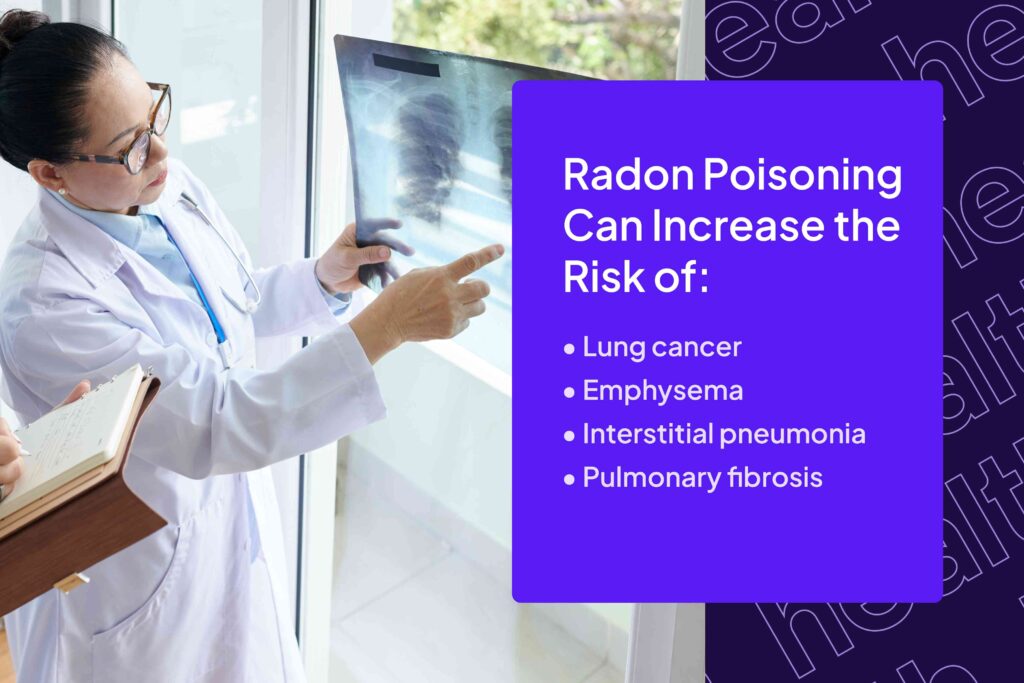:max_bytes(150000):strip_icc():format(jpeg)/HDC-Symptoms-Template-2024-radon-17755ef4728f4dc9853d30de272d2fd0.jpg)
Radon poisoning occurs when you become exposed to dangerously high levels of radon, a naturally occurring, odorless, and colorless radioactive gas.
Radon is produced when uranium, a radioactive element, breaks down in soil, rock, and water in the environment. It is then released into the air. When you inhale excessive levels of radon, it can raise your risk of serious conditions like lung cancer, emphysema, pneumonia, and pulmonary fibrosis.
Design by Health / Getty Images
Radon poisoning is the second most common cause of lung cancer after smoking.
Inhaling normal amounts of radon does not lead to cancer, but you may develop lung cancer after years of living or working in a building with dangerously high radon levels. Cancer may develop faster in people who currently smoke or have smoked in the past and also live in high-radon homes.
Radon molecules can attach to dust. When inhaled, this leads to symptoms such as irritation and inflammation. It can also cause cell damage, increasing your risk of lung cancer. Common signs of lung cancer include:
- Persistent cough
- Hoarseness
- Wheezing
- Coughing up blood
- Shortness of breath
- Chest pain
- Frequent respiratory infections
- Loss of appetite
- Unexpected weight loss
- Fatigue and weakness
Exposure to high levels of radon may also increase the risk of emphysema, a form of chronic obstructive pulmonary disease (COPD) that makes breathing harder.
Air sacs in the lungs should expand when you inhale (breathe in) and deflate when you exhale (breathe out). In people with emphysema, some of these air sacs are damaged, making it more difficult to move air in and out of the lungs. Air may also become trapped in the lungs.
People with early-stage emphysema may not experience symptoms. As the condition worsens, you may experience the following symptoms:
- Persistent cough
- Wheezing
- Coughing up large amounts of mucus
- Chest pain
- Shortness of breath
- Frequent respiratory infections
- Swelling in feet, ankles, and legs
- Unintentional weight loss
Radon poisoning may also lead to chronic interstitial pneumonia, a lung disease that causes inflammation in the air sacs in the lungs. This type of pneumonia may last for an extended period and lead to lung damage. Possible signs of chronic interstitial pneumonia include:
- Persistent dry cough
- Shortness of breath
- Trouble breathing
- Fever
- Unintentional weight loss
- Flu-like symptoms
Exposure to radon damages the lungs and may lead to pulmonary fibrosis, a chronic health condition that causes scarring in the lungs. This scarring makes it difficult for your body to get enough oxygen. Common signs of pulmonary fibrosis include:
- Dry cough
- Shortness of breath
- Fatigue
- Unintended weight loss
- Muscle pain
Children who live in homes with high radon levels may also develop radon poisoning. Children may inhale more radon than adults because they have faster breathing rates and smaller lungs, resulting in higher radon levels in the body.
Radon poisoning in children may also raise their risk of developing childhood leukemia, although more research is needed to understand this connection. Early symptoms of leukemia in children include easy bruising and bleeding, fatigue, fever, and frequent infections.
Radon poisoning does not cause symptoms on its own, but it raises the risk of certain chronic health conditions. Exposure to high radon levels increases the risk of stroke in people assigned female at birth. About 60% of stroke deaths occur in females, so this statistic connection is important to keep in mind.
Symptoms of stroke include facial drooping, arm weakness, and speech difficulty. Females may also experience more vague symptoms, including fatigue, weakness, and confusion.
Radon poisoning is not contagious, but it does raise the risk of serious respiratory health conditions like lung cancer and emphysema. These conditions cause coughing, which can release respiratory droplets into the air. Respiratory droplets may carry bacteria and viruses that spread illness.
To lower the chances of spreading infection through coughing, try to cover your mouth with a tissue or the crook of your elbow.
Radon poisoning does not cause any physical signs or symptoms, so it may be difficult to know when to contact your healthcare provider.
To understand if you are at risk of radon poisoning, have your home tested by a professional. It’s also important to see your healthcare provider if you develop symptoms like a persistent cough, hoarseness, coughing up blood, chest pain, and shortness of breath.
Radon poisoning happens when you become exposed to high levels of radon (a toxic, odorless, and colorless gas) over a long period of time.
While radon poisoning does not cause symptoms on its own, it can raise your risk of serious conditions like lung cancer, emphysema, and pneumonia. Common symptoms of these conditions include a cough and shortness of breath. While these may initially seem harmless, seeing your provider for proper diagnosis and testing is important.













